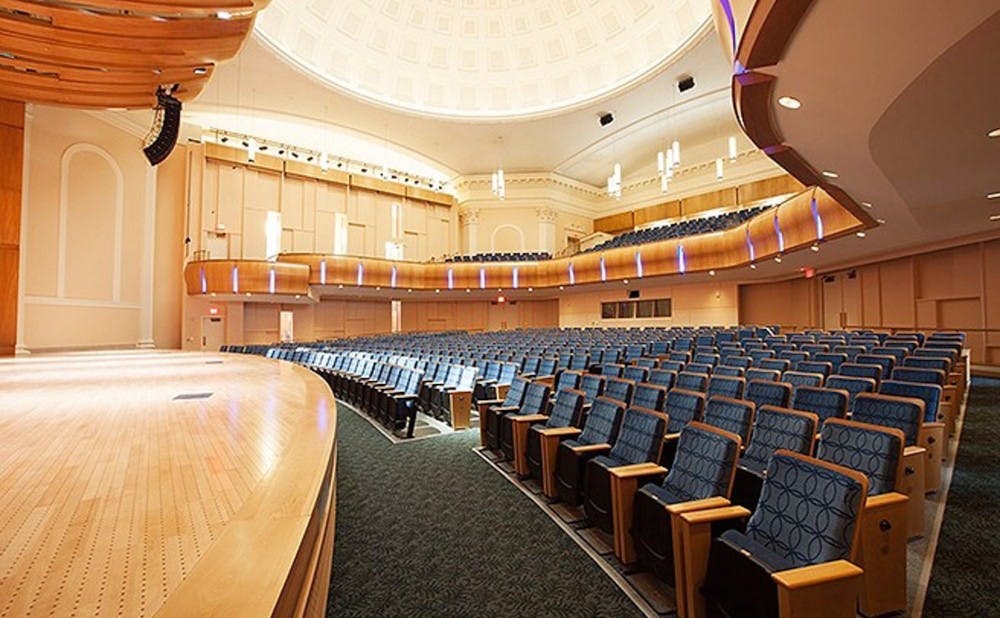Canadian-born virtuoso Marc-André Hamelin performed at Baldwin Auditorium Nov. 17.
Known for his outstanding technique and monstrous velocity, Hamelin is capable of performing the most challenging works ever composed for the piano. He is a regular performer at Carnegie Hall in New York City and has appeared at some of the most celebrated venues. In fact, the artist had just flown in to Durham after performing in Carnegie Hall’s Stern Auditorium for his appearance at Duke.
Beyond his prestigious awards and accolades, the classical pianist is well-known for diversifying his repertoire of classical music giants with rarely performed works by esteemed pianist-composers of the 19th and early 20th centuries. Hamelin brought to Duke exactly that: pieces by three lesser known composers from the early 20th century framed by the most celebrated works of Bach and Chopin.
As Hamelin modestly entered the spotlight, a wave of charged applause overcame the small, intimate auditorium. Yet the few hundred seats, filled mostly with an elder audience, were not full.
When asked how he liked performing at Duke, Hamelin said, “It’s nice. I was just worried that the hall is so live that … you want to hold back the sound sometimes because everything is so loud.”
He began his solo concert with the majestic chords of Ferruccio Busoni’s most celebrated transcription of J.S. Bach’s Chaconne in D-minor. Originally written for solo violin, Chaconne is the fifth and final movement of Partita No. 2. But the fifth movement often stands alone, lasting as long as the first four movements combined and presenting a challenging solo work tackled by every piano virtuoso.
This sublime piece arose from tragedy that befell Bach in 1720. Some historians theorize that after traveling for three months with Prince Leopold, Bach faced the jarring news that his wife had passed away and was already buried. It is postulated that, left to raise four children, Bach wrote the emotionally charged Chaconne while consumed with grief.
No one can be left untouched by this powerful composition. Under Hamelin’s fingers, the grand piano emulated the sound of a church organ. He skillfully explored the richness of the work through variations and structural details. High concentration overcame the audience as Hamelin moved from the key of D-minor to a more optimistic part in D-major about half way through the piece.
Hamelin then played the works of lesser known composers who were all accomplished pianists: Samuil Feinberg, Alexis Weissenberg and Mario Castelnuovo-Tedesco. All three were Jewish, and all were victims of political turmoils in their respective countries.
Samuil Feinberg, born at the end of the 19th century in Russia, witnessed the Russian Revolution and fought in WWI. After he achieved some fame, Stalin prohibited him from leaving the Soviet Union and performing in other countries.
In his childhood Alexis Weissenberg escaped German-occupied Bulgaria with his family and settled in New York City, where he became a professor at the Juilliard School.
Mario Castelnuovo-Tedesco fled Mussolini’s fascist regime in Italy, after anti-Jewish laws censored his performances and any performances of his compositions, and settled in California.
Hamelin followed the baroque style of Bach with a modern work. Despite being from opposite time periods, Bach’s Chaconne and Feinberg’s Sonatas shared the trait of being the most abstract in Saturday’s repertoire. Influenced by the music of Scriabin, as well as by Prokofiev, Taneev, Medtner, and Stanchinsky (another lesser known composer), Feinberg’s 5th and 6th Sonatas were forward-thinking and original, often mysterious and agitated.
“I loved the sixth Feinberg Sonata with its feverish qualities and wild and devilish themes,” said freshman Devon Valdez, a piano student.
Each consisting of one movement, the pieces were technically demanding and complex works, challenging not only for the performer, but for a listener as well. Samuil Feinberg wrote 12 Sonatas altogether, and they are a work-in-progress for Hamelin.
“I’m actually recording the first six in a month in Berlin," Hamelin said. "It probably will come out in ten to twelve months."
Weissenberg’s works introduced a jazzy playfulness that even those with an ear unfamiliar to classical music could fall in love with, giving listeners a break from the cerebral and emotionally intense works of Bach and Feinberg. The pieces were arrangements of songs by Charles Trenet, a popular singer and songwriter from the south of France, whose subject matter ranged from love and nostalgia to more surreal, whimsical imagery. Upholding Trenet’s sun-filled and joyful colors, Hamelin finished the pieces with a smile, and the audience shared his rejoicement as they applauded with a hint of laughter.
Hamelin then traveled slightly back in time, continuing with a far more somber piece, Cipressi by Castelnuovo-Tedesco, Feinberg’s contemporary. In some cultures, cypresses symbolize the end of life. The composer was from Tuscany whose landscape is dotted with cypress trees. With an impressionistic texture, the piece conjures up nostalgia, telling the story of and drawing a native landscape.
“His Weissenberg and Tedesco were beautiful and absolutely a joy to hear with a great variety of color and excellent attention to different moods and voicing,” Valdez said.
Finally, Hamelin ended his program with two romantic works by Chopin, both in major keys. And as the audience gave him a standing ovation, Hamelin sat back down, following his performance with an encore consisting of two pieces: Rachmaninoff’s powerful "Prelude in B flat Major" and a short piece from Schumann’s "Forest Scenes."
Get The Chronicle straight to your inbox
Sign up for our weekly newsletter. Cancel at any time.

